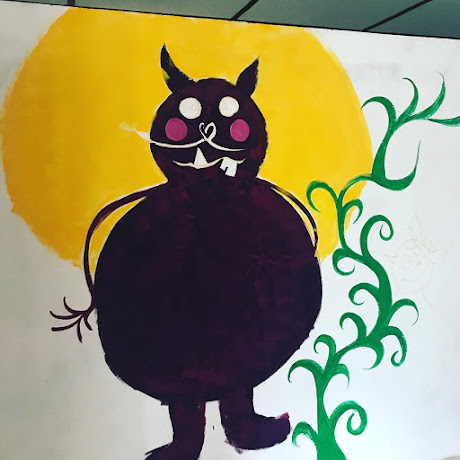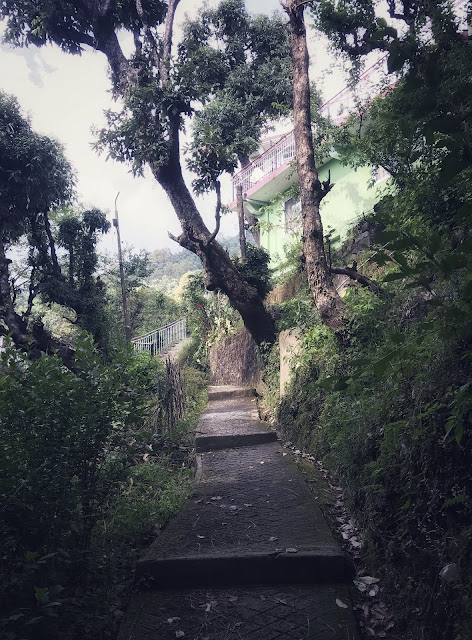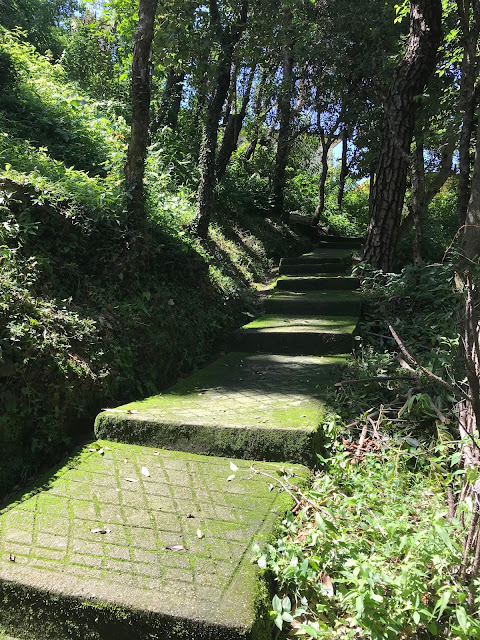This write-up is about painting a story-wall in the nursery room of a
government primary school. The idea is to paint illustrations from children's
books, so that when children are back in school, the walls can be used for
storytelling.
Background:
I had first seen a few artists create a story-wall in 2018, at a
government school in Gurgaon. The artists were already quite experienced in
creating wall murals. We additionally requested them to use illustrations from
children’s story books that we had gifted to the school. They deftly re-created
the illustrations on the wall, which we then used for a storytelling session
with the children. The children were fascinated! They kept looking at walls in
the classroom, unable to take their eyes off the walls.
My second experience of seeing a story-wall was in the same year, in
Majuli. I was volunteering my time to set up a library for Ayang Trust. They
had also invited an artist to paint illustrations from children’s story books,
on the walls of the library. Again, the wall turned out to be beautiful. This
time I watched the artist much more closely and was myself quite fascinated
with the process. So much so that when the artist left, I took it upon myself
to use the leftover paints to paint every surface I could lay my hands on
(mostly newly constructed plywood shelves, clay pots and so on)! I really loved
the medium of acrylic colors, especially when using it on plywood. I found it
meditative to spend hours mixing the blues and spreading it on the different surfaces
– I think I was painting after over a decade.
The following year, I procured some supplies, a canvas and spent quite a
bit of time exploring the medium by itself and the result of these explorations
were a few paintings. But more than that, I felt like these explorations
allowed me to express myself in a way that I couldn’t do through words. At the
same time, I started exploring other art forms, not just limited myself to
visual arts, but also other forms like like Kathak, Hindustani Classical music
and even Hindi poetry! A lot of times felt like I was back to my childhood
days, when every weekend would be packed with painting, music and dance lessons
and how as an adolescent I used to write Hindi poetry that was mostly hidden
away. Recollecting and revisiting these varied experiences have shaped my
current understanding of art and its purpose (and continue to do so). The
cherry on the cake was undergoing an art education programme for educators, which helped strengthen my understanding of the role of
arts in the development of a child.
One of the things that I try to do, is to help children be comfortable
with and even proud of whatever they create, instead of being constantly
critical of their work. But saying is hardly enough, especially when you’ve not
experienced the vulnerability and have done something to overcome it. So with
great hesitation I started putting myself in the same vulnerable spot by
sharing my own art explorations with other people. And results were exactly the
same as I’ve seen in the classroom. When a child who is focused on the
imperfections of their work hears encouraging feedback from others on the
‘beauty’ of their work, they themselves start looking at their work from a new
perspective.
For me, this project embodied everything that I encourage children to do
– to be confident of their abilities, to push themselves to explore the
unknown, to take on more challenging projects and to own their output with
pride. Hence it was much, much more than a one-time side project that I took up
to use my time meaningfully during the holiday season. It was a small piece of
the bigger art composition that is still in the making.
Location: Government Primary
School, Tika Khas, Dharmshala, Himachal Pradesh. The school has recently
undergone renovations and the room had recently received a coat of plastering
and whitewashing, making the wall a great canvas.
Time taken to
accomplish the task: Approx 20
hours, spread over seven sittings (Dec 2020 – Jan 2021)
Materials used:
- Print outs of illustrations
- Colored chalk/ soft pastels
- Brushes (thick flat brush, 2-3 round brushes (I used
12 no. from Faber Castell) and palette
- Small paint roller and flat palette
- Acrylic paints – I used Fevicryl 500 ml bottles in
primary colors, white, green, teal (also used up some leftover supplies I had
from before)
- Small tubes of Faber Castell acrylics (24 shades), primarily to add
multiple tints
- Napkins, towels, newspapers, old cloth
- A big bucket of water for cleaning brushes etc
- It's helpful if the surface that you're painting on is smooth
- Chair/ floor mat/ anything else for sitting at various heights
- Trash bin
I primarily spent money on paint, which cost me around INR 2000 (I
bought 500 ml bottles of most paints, when only 250 ml would’ve been sufficient.
So I still have enough paint left for another wall).
Step 1 - Choice of story and illustrations
I decided to go with the story The Pleasant Rakshas (written by
Sowmya Rajendran and illustrated by Niveditha Subramaniyam, published by Tulika
Books). I don’t
remember exactly when or how I first came across this book, but I do remember
using this story for storytelling to a group of primary school children. And it
was a hit!
The protagonist, a monster named Karimuga is
unconventionally beautiful (the text subverts the concept of beauty). He is
purple in color and has bright pink cheek. His teeth are bright yellow like the
wild flowers that grow in the jungle. He has a huge belly and is super hairy.
All the other rakshas wish they could be as beautiful as him. But Karimuga is
not just beautiful on the outside, but on the inside too. He doesn’t want
anyone to feel bad because of him so he decides to share all his beauty with
the other rakshasas. And as happy as this makes him, he also feels a little
pang of sadness.
I found this sadness to be the most sensitive
part of the story. Isn’t this what most people, especially children, would feel
when they’re laden with the burden of being ‘good’? Yes, values are important,
but what do children actually feel when they have to share their things with
others? Does the knowledge that they’re winning the approval of adults around
them make them magically feel better? For example, Karimuga had the agency to
decide whether he wanted to share his beauty with the other rakshasas. But even
that didn’t make the entire burden of sharing easier for him. I wonder what it
would be like to open this question to children during a storytelling
discussion.
I also love the simple, colourful illustrations
of the monsters with their imperfections. I thought the younger kids would be
able to relate to something like that easily. Also the lines and colors in
the illustrations are such that they're simple and fun, yet they would be more
forgiving in terms of imperfections that might creep in (since I have no prior
experience with this). And I loved the bright colors! I also felt I could try
to create different textures, so there was enough scope for experimentation. I
decided to put together elements from different sections of the story in sort
of a collage.
Step 2: Drawing rough
outlines using chalk/ soft pastels
I went through this step even before the wall
was plastered and whitewashed, when the wall just had a cement coat. I used
soft pastels (it is perfectly fine to use chalk as well) to create rough
outlines of the characters, to get a sense of space and composition. It also
helped me in overcoming the procrastination that precedes an ambitious project
like this. After that initial chalk drawing, I was confident that I would be
able to do a decent job of it all.
It was helpful that I did this before the wall
had been plastered. It helped me in being less nervous; if something went
horribly off, the wall could simply be whitewashed. Although looking back I
think it would’ve been fine even if I’d done this after the wall has been
whitewashed, because the soft pastels were easily covered when I started using
the acrylics.
Step 3: Covering big
areas with paint
Once the wall had been whitewashed, I drew the characters once again,
with some alterations and started painting the bodies of the monsters first. I
first painted the central character – not just because it covered the most
surface area, but also because all other characters would have to be done in
relation to this character. So I painted the body and the big yellow halo
around its head. I mixed the blue and red paints to get a purple. Even though
it was darker that I wanted, it stood against the white background and the
yellow halo, so I let it be. I also painted the bodies of a couple of other
monsters. I tried to recreate the textures, instead of painting blocks of solid
colors. This not only broke the monotony that big patches of solid colors can
bring, but complimented the essence of the story.
Step 3: Adding finer
details and background colors
Once the big patches were done, I added some background colors and finer
details like the details on the face (eyes, smiles, teeth, nose etc). Once that
was done, I used black outlines to define the features of the monsters. Even
though I had to touch up most of the boundaries once again towards the end,
doing this simultaneously gave me a sense of small accomplishments as I went
along, which helped me in staying motivated until the end. At this stage, I had
to sometimes use double coats of paint as well, since the tints of Fevicryl
paint wasn’t as intense as I would have like it to be. I think it might be
easier to paint the outlines using acrylic tube paint instead.
Step 4: Adding
finishing touches
This meant covering
and gaps which stood out, as well as applying a second (or even third) coat of
paint, especially on the outlines. I also used soft pastels to cover any blank
areas - this was otherwise difficult to do using acrylic paints (and a brush).
I did arrive at a point where all of a sudden I was like, 'hmm, this is
done now'. Was it perfect? No. But then, I never meant for it to be perfect
either. But in that moment, it struck me that it was actually done. This
mammoth piece of project that I'd been working on for a full month was actually
done (still feels quite surreal)! I took a step back (literally) and spent a
few minutes looking at it and I could feel a sense of happiness fill up my
entire being. Before I knew it, I was grinning away to glory. I was super proud
and I wanted to celebrate it. Cherish it. Stay with it. Smile at it. And in
that moment, I could see myself sitting in that space with the kids, sharing
smiles and cake :)
Step 5: Storytelling (work in progress)
At this point, I don't know when would the kids be back in school, so I don't know when would I get to use this wall to narrate the story to them. However, I had prepared a little script sometime ago, which I'm revisiting right now. This includes a little song that I composed myself :) Here's the current version of the script, in Hindi.
Brief character sketch:
- Karimuga is a pleasant, happy-go-lucky monster. He is simple and sensitive and gets along with everyone. He smiles a lot and behaves like a little child.
- Gyani Ped Baba is ancient and hence there is a slowness about him (he probably sleeps most of the time!).
- The green rakshas, who gets hairy legs, has a Goofy-like quality to him; he laughs with hiccups in between. Is also probably the most fashion-conscious rakshas of the entire lot :D
- The blue (female) rakshas gets the red eyes. She's the cutest of them all.
- The red rakshas gets the paunch. He is big and bulky and walks like a fat guy.
- The black rakshas gets purple body color. He is a little angry at all times.
एक राक्षस था| दुसरे राक्षसों से बिलकुल अलग| उसका नाम
था करीमुगा| करीमुगा एक हँसमुख राक्षस था| उसका रंग जामुनी और और गाल गुलाबी थे| उसके पास एक
बड़ी सी तोंद और रोएंदार टाँगे थी| आँखें बिलकुल लाल| और उसके दाँत? उसके दाँत जंगल में उगने वाले जंगली
फूलों की तरह पीले थे| रात में जब करीमुगा मुस्कुराता,
तो पतंगे उसके दाँतों के आस पास ऐसे मँडराते, जैसे
उसके दाँत अँधेरे में जलती मोमबत्तियाँ हों! और करीमुगा तो हमेशा ही मुस्कुराता
रहता था! पर दूसरे राक्षसों को उसकी मुस्कराहट और सुंदरता से बड़ी जलन होती थी|
काला राक्षस कहता,
"उसका
जमुनी रंग तो देखो! काश मेरा रंग भी इतना सुन्दर होता.."
नीला राक्षस कहता,
"उसकी लाल
आँखें तो देखो! मेरे नीले रंग के साथ कितनी अच्छी लगती न!"
लाल राक्षस कहता,
"वह देखो
उसकी बड़ी सी तोंद!"
और हरे राक्षस को
करीमुगा की टांगें बहुत पसंद थी| वह कहता, "इतनी सुन्दर टाँगें! ऐसी टाँगें पाने के लिए तो मैं कुछ भी
कर सकता हूँ!"
फिर सारे राक्षस मिल
कर एक गाना गाते:
करीमुगा का रंग तो देखो रंग तो देखो
करीमुगा की आँख तो देखो आँख तो देखो
करीमुगा के दाँत तो देखो दाँत तो देखो
करीमुगा की तोंद तो देखो तोंद तो देखो
सबसे सुन्दर करीमुगा है करीमुगा है!
एक दिन करीमुगा ने
दूसरे राक्षसों की बातें सुन ली| बातें सुनकर वह पहले तो बड़ा खुश हुआ,
पर फिर वह थोड़ा उदास हो गया| वह नहीं चाहता था उसके दोस्त उसकी वजह से उदास हों|
तो इस समस्या का हल निकलने के लिए वह गया ज्ञानी पेड़ बाबा
के पास|
ज्ञानी पेड़ बाबा जंगल के सबसे बुजुर्ग पेड़ थे|
सारे लोग अपनी समस्या लेकर उनके पास जाते थे|
करीमुगा पेड़ बाबा के पास हाथ जोड़ कर खड़ा हो गया|
फिर बोला,
"पेड़ बाबा,
क्या आप
मेरी सुंदरता ले कर मेरे दोस्तों को दे सकते हैं?"
ज्ञानी पेड़ बाबा ने
पूछा, "क्यों?"
करीमुगा ने कहा
"वो मैं अपनी सुंदरता से थोड़ा बोर हो गया हूँ|
आप प्लीज
मेरी सुंदरता लेकर मेरे दोस्तों में बाँट दीजिये"
ज्ञानी पेड़ बाबा थोड़ा
मुस्कुराये| फिर उन्होंने कहा "तथास्तु!"
करीमुगा बड़ा खुश हुआ!
भागते भागते उसने चिल्लाकर कहा "थैंक यू पेड़ बाबा,
थैंक
यू!"
करीमुगा भागते भागते
अपने दोस्तों के पहुँचा| वहाँ तो क्या नज़ारा था! काला राक्षस अब जमुनी हो गया था|
सारे राक्षस बहुत खुश थे| हरे राक्षस के पास सुन्दर, रोयेंदार टाँगें थीं| लाल राक्षस के पास अब बड़ी सी तोंद थी,
जिस पर वह बार बार हाथ फेरे जा रहा था|
और नीले राक्षस को मिली थी सुन्दर लाल आँखें!
अब तो सारे राक्षस
मुस्कुरा रहे थे, सिवाय करीमुगा के| उसके शरीर का जामुनी रंग गायब हो गया था|
आँखों का सुन्दर लाल रंग भी उड़ गया था|
टाँगों पर एक भी रोयां नहीं था और उसकी गोल मटोल तोंद
छूमंतर हो गयी थी!
दूसरे राक्षसों ने
करीमुगा की उदासी समझ ली| लाल राक्षस ने कहा, "मेरे पास एक आईडिया है!" यह कहकर वह करीमुगा को
गुदगुदी करने लगा| यह देख कर बाकी सारे राक्षस भी करीमुगा को गुदगुदाने लगे|
करीमुगा हँसते हँसते ऐसा लोटपोट हुआ की वह पहाड़ के नीचे
लुढ़कने लगा! और लुढ़कते लुढ़कते वह जा पहुँचा नदी के तट पर|
वह नदी में गिरने ही वाला था कि अचानक उसे पानी में अपना
चेहरा दिखा| उसके दाँत तो अब भी पीले थे! यह देख कर वह जोर जोर से हँसने
लगा|
और करीमुगा एक बार फिर से एक हँसमुख राक्षस बन गया!
Post session activity:
The potential activity (for 3-5 year olds) could be creating monsters using paper collage - they could cut/ tear big pieces to create body parts and add finer details.
Acknowledgements:
Throughout the project, I had full support of the
school head teacher, Mrs. Prerna Sood. This ensured that I not only had easy access to the room for
painting, but she also made other resources available – like chair, buckets and
so on. It was also quite helpful that she had given me the freedom to decide
what I wanted to paint on the walls and was quite encouraging throughout.











